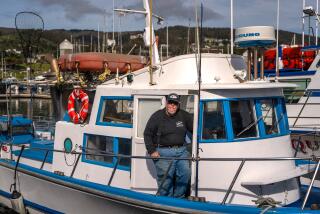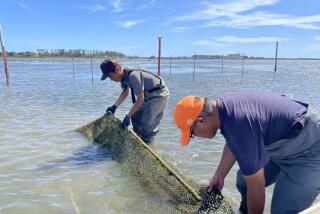Pacific on the fly
- Share via
When Chris Jorgensen wants to “get his head on straight,” he heads to a placid trout stream.
But for a bigger rush, he takes his fly rod to the beach, because saltwater for him is “pure adrenaline.”
Jorgensen, a Whittier entrepreneur who owns a boat repair business, also figures a drive to the Pacific is a lot quicker than six hours to the Sierra.
Fly anglers hunt a variety of saltwater game fish, including perch, small bass and corbina in the surf, and halibut and calico bass in the harbors. Some even go for deep-sea big game such as albacore, barracuda and yellowtail.
Fishing the ocean is an adjustment for anglers used to tiny trout flies. Salt-water “flies” don’t mimic insects, as fresh-water flies do, but, instead, imitate sand crabs, squid and shrimp, plus baitfish such as anchovies and sardines.
If you use only one fly, Dave Shaffer, fishing manager at the Orvis store in Pasadena, recommends a Clouser minnow -- with its dumbbell-shaped eyes and upside-down hook -- because it sinks easily and doesn’t snag much in cover.
You can forget bringing that dinky, lightweight fly rod you use on the west fork of the San Gabriel River. Ocean fly fishing requires gear with muscle. “A 6-weight is pushing the envelope” of being too light, says Frank Selby, owner of the Costa Mesa-based His and Hers Fly Shop. He says a good rod for the surf or bay is an 8- or 9-line-weight rod.
To hook big game offshore, you have to bulk up further. Hooking a sailfish requires a 12- or 14-weight rod, says John Stevenson, a member of the Saltwater Flyrodders Pacific No. 1 Club, based in Montrose. He uses foot-long flies that simulate baitfish such as anchovies and a sinking line to get the fly down deeper to where the fish are.
Beginners might have better luck at jetties than on the beach, where casting into the surf takes some getting used to, says Jorgensen. From the jetty, simply shake out some line, roll cast it, then strip it back.
Distance rather than accuracy is the goal when it comes to ocean casting. “You’re not fishing for seagulls,” says Selby, who, instead, recommends using a side cast, starting and stopping the cast sooner.
Saltwater fly anglers need to survey the water, just as a trout angler would a freshwater stream. Watch for birds at the surface and schools of baitfish being chased by big game fish.
Tides are important. Slack water might be easier for anglers, but moving water means more fish, Shaffer says. “Tides turn everything up. They create rips and funnels of food,” he says. Local ocean anglers catch most of their fish during an incoming low tide or mid-tide, Selby says.
Keep an eye on where waves break. Currents dig troughs parallel to the shore, and this is where many game fish can be found. Jorgensen calls these the “corbina highway.” Notoriously tough to hook, corbina are croakers found at California beaches and shallow bays. They feed mostly on sand crabs and converge here as the water warms.
Having a fish hit a lure at 35 mph “is exciting and why I go out there,” Jorgensen says. The biggest fish he’s caught on a fly? A 22-pound yellowtail from a boat on the backside of Catalina Island, using a chartreuse Clouser pattern thrown into a kelp paddy. “That fish turned me every which way but loose.”
If you’ve got to fly, there are plenty of Pacific runways. Check out Redondo Harbor, Santa Monica Bay between Venice and the Marina del Rey breakwater and Newport Bay in Orange County.
His and Hers Fly Shop offers guiding, surf-casting and fly-tying classes and private lessons. (949) 548-9449. Orvis sponsors saltwater trips and offers fly-tying seminars. (626) 356-8000.
To e-mail Julie Sheer or read her previous Outdoors Institute columns, go to latimes.com /juliesheer.
More to Read
Sign up for The Wild
We’ll help you find the best places to hike, bike and run, as well as the perfect silent spots for meditation and yoga.
You may occasionally receive promotional content from the Los Angeles Times.






